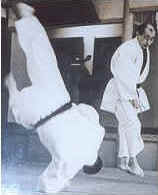| 6th Kyu |
White |
Core
Skills:
Technique:
Application: |
Unsoku
- Complete (3 Sections)
Ukemi - Side and Back breakfall
Randori-no-kata 1-5
1. Shomen-ate
2. Ai-gamae-ate
3. Gyaku-gamae-ate
4. Gedan-ate
5. Ushiro-ate
Performed on candidate's 'natural' side.
i.e. candidate's choice of left or right.
Kakarigeiko - Single attacker, Open-handed attack which must include Shomen-ate and Yokomen-uchi.
|
Timescale:
More than 2 months from start date.
Minimum of 20 hours practise. |
| 5th Kyu |
Yellow |
Core
Skills:
Technique:
Application: |
Tandoku-undo
- Sections 1-3
Ukemi - Forward Roll
Randori-no-kata (1-5
and 6-10)
1. Shomen-ate
2. Ai-gamae-ate
3. Gyaku-gamae-ate
4. Gedan-ate
5. Ushiro-ate
6. Oshi-taoshi
7. Ude-gaeshi
8. Hiki-taoshi
9. Ude-garame
10. Waki-gatame
Performed left or right, examiner's choice.
Kakarigeiko - Single attacker with or without Tanto, to include Shomen and Yokomen
(Aigamae
and Gyakugamae) attacks.
See note 2
|
Timescale:
More than 2 months as 6th Kyu.
Minimum of 20 hours practise as 6th Kyu. |
| 4th Kyu |
Orange |
Core Skills:
Technique:
Application:
|
Tandoku-undo - complete (Sections 1-5)
Ukemi - Kote-gaeshi, supported
Shikko - Forward & Turning
Suwari-waza - 2 techniques
Randori-no-kata (1-5 and 6-10
and 11-14)
1. Shomen-ate
2. Ai-gamae-ate
3. Gyaku-gamae-ate
4. Gedan-ate
5. Ushiro-ate
6. Oshi-taoshi
7. Ude-gaeshi
8. Hiki-taoshi
9. Ude-garame
10. Waki-gatame
11. Kote-hineri
12. Kote-gaeshi
13. Tenkai-kote-hineri
14. Shiho-nage
Performed left or right, examiner's choice.
Kakarigeiko - Grasp attacks, Aigamae and Gyakugamae.
Tanto Kakarigeiko - Single attacker with Tanto.
|
Timescale:
More than 4 months as 5th Kyu.
Minimum of 40 hours practise as 5th Kyu. |
| 3rd Kyu |
Green |
Core Skills:
Technique:
Application: |
Ukemi
- Sumi-otoshi, supported.
Suwari-waza - 4 techniques
(Candidate's choice, both students kneeling)
Randori-no-kata (1-5 and 6-10
and 11-14 and 15-17) (17 techniques)
1. Shomen-ate
2. Ai-gamae-ate
3. Gyaku-gamae-ate
4. Gedan-ate
5. Ushiro-ate
6. Oshi-taoshi
7. Ude-gaeshi
8. Hiki-taoshi
9. Ude-garame
10. Waki-gatame
11. Kote-hineri
12. Kote-gaeshi
13. Tenkai-kote-hineri
14. Shiho-nage
15. Mae-otoshi
16. Sumi-otoshi
17. Hiki-otoshi
Randori-no-kata-no-ura-waza 1-5 (Counters 1-5)
1. Shomen-ate - Waki-gatame
2. Ai-gamae-ate - Kote-mawashi
3. Gyaku-gamae-ate - Gedan-ate
4. Gedan-ate - Ai-gamae-ate
5. Ushiro-ate - Tenkai-kote-hineri
Kakarigeiko - Multiple attackers e.g. Ninindori, with variation of attack,
open-handed.
Hikitategeiko - Single attacker with Tanto.
Objective: Movement - 'passive' (no
counters)
|
Timescale:
More than 4 months as 4th Kyu.
Minimum of 40 hours practise as 4th Kyu. |
| 2nd Kyu |
Blue |
Core Skills:
Technique:
Application: |
Ukemi
- floating/falling leaf
(Performed alone.
Similar to Koryu-Dai-San. No. 1 Suwari-waza)
Shichi-hon-no-kuzushi 1-7
(To show balance disturbance,
circular movement and control - no
breakfalls)
Randori-no-kata 1-17 (17 techniques)
Randori-no-kata-no-ura-waza 1-10
Counters 1-10 (10 techniques)
1. Shomen-ate - Waki-gatame
2. Ai-gamae-ate - Kote-mawashi
3. Gyaku-gamae-ate - Gedan-ate
4. Gedan-ate - Ai-gamae-ate
5. Ushiro-ate - Tenkai-kote-hineri
6. Oshi-taoshi - Kote-mawashi
7. Hiki-taoshi - Tenkai-kote-hineri
8. Kote-gaeshi - Kote-gaeshi
9. Tenkai-kote-hineri - Waki-gatame
10. Shiho-nage - Shiho-nage
Kakarigeiko - Ninindori
Hikitategeiko - Single attacker with Tanto - 'active' (with counters).
|
Timescale:
More than 6 months as 3rd Kyu.
Minimum of 60 hours practise as 3rd Kyu. |
| 1st Kyu |
Brown |
Core
Skills:
Technique:
Application:
|
Shichi-hon-no-kuzushi 1-14
(To show balance disturbance, circular movement and
control - with breakfalls)
Randori-no-kata 1-17 (17 techniques)
Counters 1-10 (10 techniques)
Kuzushi - Demonstration of a variety of balance disturbances for
randori.
Koryu-dai-san
1. Oshi-taoshi
2. Gyaku-gamae-ate
3. Kote-gaeshi
4. Ryote-mochi-sukui-nage
5. Tenkai-kote-hineri
6. Shiho-nage
7. Gedan-ate
8. Hiji-kime
Suwari-waza Section A (8 techniques)
Hikitategeiko - Empty-handed (Toshu) |
Timescale:
More than 9 months as 2nd Kyu.
Minimum of 120 hours practise as 2nd Kyu. |
|
Notes:
2. Candidate: From 5th Kyu onwards, and with the exception of
Koryu-dai-San, candidates will be expected to be able to demonstrate on
left or right at examiner's choice.
3. Coaches: Gohon-no-Kuzushi, currently shown in BAA syllabus
at 2nd Kyu, is recognised as a training method and should be incorporated
into practice sessions.
4. Coaches: Tanto Randori-no-Kata is recognised as a training
method and should be incorporated into practice sessions.
5. At all levels after 6th Kyu, previous syllabus will be
required at the discretion of the examiners.
6. Duration, intensity and quantity of the ‘Application’
sections will be at the discretion of the examiners. |
|
|
|
|
|
|
|
|
| 1st Dan |
Black |
Technique:
Application:
|
Koryu-Dai-San - Section B and C
- 16 (8+8)
Koryu-Dai-Yon complete - 1-25 (14+11) note1/2
Randori - Tanto and Toshu
(empty-handed)
Combinations and Counters - 5 of each, candidates' choice |
Timescale:
1 year consistent
practice as 1st Kyu |
| 2nd Dan |
Black |
Technique:
Application:
|
Koryu-Dai-San
- Section D, E and F - 18 (5+5+8)
Koryu-Dai-Ichi, Section A - 1-5
Randori as required - Tanto and Toshu
|
Timescale:
2 years consistent
practice as 1st Dan |
| 3rd Dan |
Black |
Technique:
Application:
|
Koryu-Dai-San
complete - 1-50 (8+8+8+5+5+8+8)
Koryu-Dai-Ichi complete - 1-24 (5+7+6+6)
Randori as required - Tanto and Toshu
|
Timescale:
3 years consistent
practice as 2nd Dan |
| 4th Dan |
Black |
Technique:
Application:
|
Koryu-Dai-Ni
complete - 16 (11+5)
Goshin-ho-no-Kata - 1-19 (8+5+2+2+2)
Randori as required - Tanto and Toshu
|
Timescale:
4 years consistent
practice as 3rd Dan |
| 5th Dan |
Black |
Technique:
Application:
|
Koryu-Dai-Go
complete - 23 (7+5+6+5)
Goshin-ho-no-Kata - 20-37
Randori as required - Tanto and Toshu
|
Timescale:
5 years consistent
practice as 4th Dan |
| 6th Dan |
Black |
Technique:
Application:
|
Koryu-Dai-Roku
- 39 (5+10+7+5+4+4+4) Note 3
Goshin-ho-no-Kata - +15
Randori as required - Tanto and Toshu
|
Timescale:
6 years consistent
practice as 5th Dan |
|
Notes:
1. Candidates: Koryu-no-Kata – sections to be demonstrated will be chosen by the examiner.
2. Examiner: Koryu-no-Kata – new sections at each level must be demonstrated, demonstration of previous sections is optional.
3. Candidates: Upon attaining 6 Dan, students will have successfully performed all the current Koryu-no-Kata;
Koryu-dai-Ichi, Koryu-dai-Ni, Koryu-dai-San, Koryu-dai-Yon, Koryu-dai-Go,
Koryu-dai-Roku.
4. At any time examiners may ask to review previous parts of the syllabus.
5. Character and attitude will be considered at each level. These include participation as a student in competitions and/or courses.
6. ‘Technique’ and ‘Application’ sections are of equal value in the assessment.
7. Age and physical ability will be taken into account throughout. |



